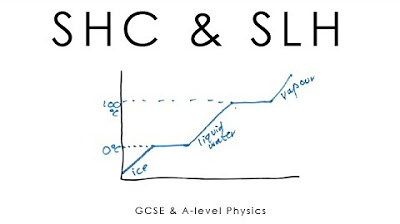FISIKA KELAS 10 - KALOR JENIS & KAPASITAS KALOR. BAB SUHU & KALOR
Summary
TLDRThis video explains the concept of heat (calor), a form of energy, and how it transfers due to temperature changes. It introduces the tools for measuring heat, such as a calorimeter, and explains the units for energy (Joules and calories). The video covers key concepts like specific heat capacity, heat capacity, and formulas used to calculate heat transfer in different materials. Through examples, it demonstrates how to calculate the specific heat capacity and the amount of heat needed to change the temperature of various substances, such as iron and water.
Takeaways
- 😀 Heat (kalor) is a form of energy that can transfer due to changes in temperature.
- 😀 A calorimeter is the tool used to measure the amount of heat energy.
- 😀 Heat can be expressed in units of Joules or calories, where 1 kilocalorie = 4186 Joules.
- 😀 Specific heat capacity (C) refers to the amount of heat needed to raise the temperature of a substance by 1°C (or 1 Kelvin) per unit mass.
- 😀 The formula for calculating heat is Q = m * C * ΔT, where Q is the heat energy, m is mass, C is specific heat capacity, and ΔT is the change in temperature.
- 😀 Heat capacity (K) is the total amount of energy required to raise the temperature of an object by 1°C or 1 Kelvin, and it is related to specific heat capacity by K = m * C.
- 😀 The specific heat capacity of a substance can be determined if the mass, heat energy, and temperature change are known.
- 😀 Example 1: A 5 kg piece of iron requires 20 kJ of energy to increase its temperature by 10°C. The specific heat capacity can be calculated as 400 J/kg·K.
- 😀 Example 2: The heat required to raise the temperature of 450g of iron from 20°C to 30°C is 2205 Joules, given the specific heat capacity of iron is 450 J/kg·°C.
- 😀 Example 3: The heat required to raise the temperature of 250 cm³ of water from 20°C to 30°C is 2500 calories, assuming the specific heat capacity of water is 1 cal/g·°C.
Q & A
What is the definition of 'calor' or heat as explained in the video?
-Heat, or 'calor,' is described as a form of energy that can transfer due to a temperature change.
What tool is used to measure the amount of heat, and what are the units used for heat?
-The calorimeter is used to measure heat. Heat can be measured in either Joules or calories. One kilocalorie equals 4186 Joules.
How is specific heat capacity defined in the video?
-Specific heat capacity (denoted as C) refers to the amount of heat required to raise or lower the temperature of a unit mass of a substance by one degree Celsius or Kelvin.
What is the formula to calculate specific heat capacity?
-The formula for specific heat capacity is Q = m * C * ΔT, where Q is the heat energy, m is the mass, C is the specific heat capacity, and ΔT is the change in temperature.
What units are used for specific heat capacity?
-The units of specific heat capacity are Joules per kilogram per degree Kelvin (J/kg·K).
What is the difference between specific heat capacity and heat capacity?
-Specific heat capacity is the heat required to change the temperature of a unit mass, while heat capacity refers to the total heat required to change the temperature of the entire object.
How do you calculate heat capacity from specific heat capacity?
-Heat capacity (C) can be calculated by multiplying the mass of the substance by its specific heat capacity (C = m * C_specific).
In the first example problem, how do you calculate the specific heat capacity of the iron bar?
-To calculate the specific heat capacity, use the formula C = Q / (m * ΔT). Given the heat required is 20,000 Joules, mass is 5 kg, and the temperature change is 10 K, the specific heat capacity is 400 J/kg·K.
How do you convert mass from grams to kilograms when solving heat problems?
-To convert mass from grams to kilograms, divide the mass in grams by 1000. For example, 450 grams is equivalent to 0.45 kilograms.
What is the total heat required to heat 250 cm³ of water from 20°C to 30°C, given the calorimeter's specific heat?
-The heat required can be calculated using the formula Q = m * C * ΔT. The mass of water is 250 grams, the specific heat capacity is 1 cal/g·°C, and the temperature change is 10°C. Thus, Q = 250 * 1 * 10 = 2500 calories.
Outlines

Dieser Bereich ist nur für Premium-Benutzer verfügbar. Bitte führen Sie ein Upgrade durch, um auf diesen Abschnitt zuzugreifen.
Upgrade durchführenMindmap

Dieser Bereich ist nur für Premium-Benutzer verfügbar. Bitte führen Sie ein Upgrade durch, um auf diesen Abschnitt zuzugreifen.
Upgrade durchführenKeywords

Dieser Bereich ist nur für Premium-Benutzer verfügbar. Bitte führen Sie ein Upgrade durch, um auf diesen Abschnitt zuzugreifen.
Upgrade durchführenHighlights

Dieser Bereich ist nur für Premium-Benutzer verfügbar. Bitte führen Sie ein Upgrade durch, um auf diesen Abschnitt zuzugreifen.
Upgrade durchführenTranscripts

Dieser Bereich ist nur für Premium-Benutzer verfügbar. Bitte führen Sie ein Upgrade durch, um auf diesen Abschnitt zuzugreifen.
Upgrade durchführenWeitere ähnliche Videos ansehen
5.0 / 5 (0 votes)






